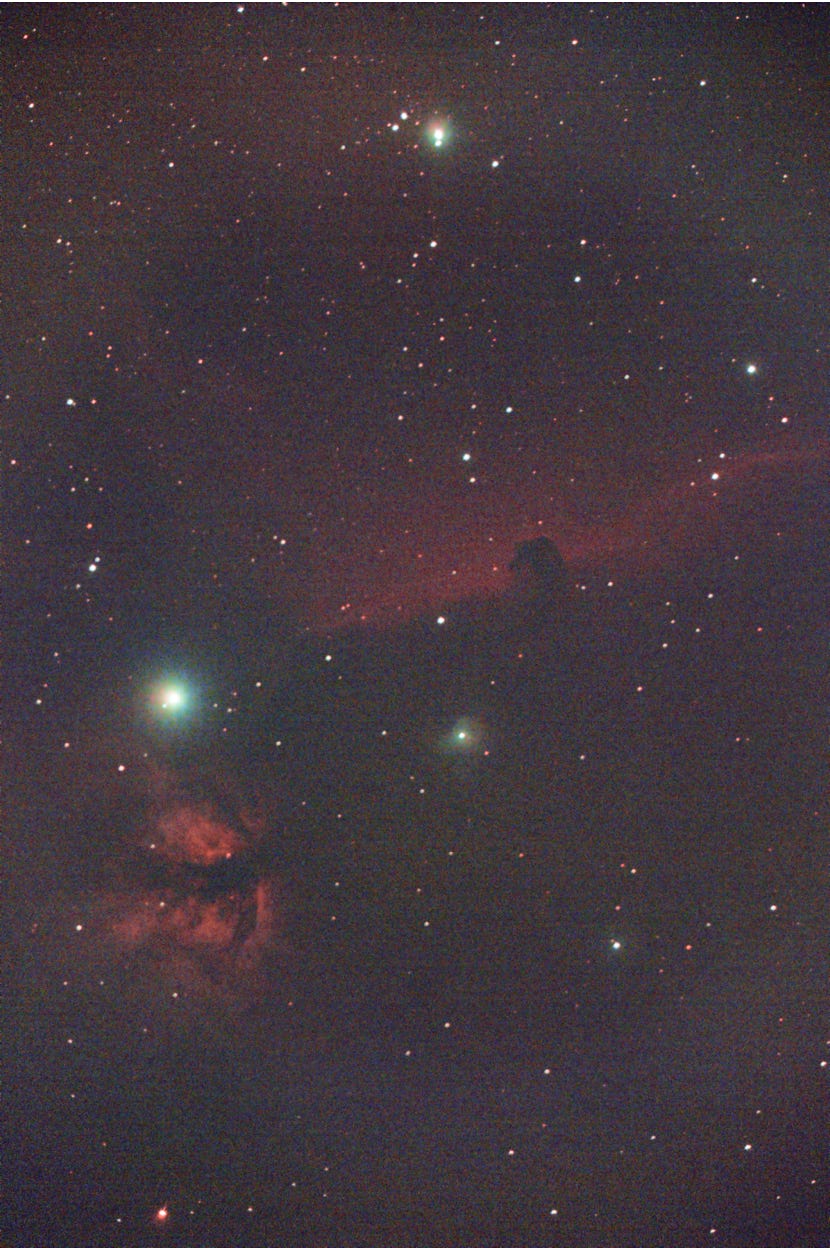Horsehead (1)
The “Horsehead Nebula” is a small dark nebula in the constellation Orion. The nebula is located just to the south of Alnitak (zeta Orionis), the easternmost star of Orion's Belt, and is part of the much larger Orion Molecular Cloud Complex. The Horsehead Nebula is approximately 1.400 light-years from Earth. It is one of the most identifiable nebulae because of its resemblance to a horse's head.
The “Horsehead Nebula” is a small dark nebula in the constellation Orion. The nebula is located just to the south of Alnitak (zeta Orionis), the easternmost star of Orion's Belt, and is part of the much larger Orion Molecular Cloud Complex. The Horsehead Nebula is approximately 1.400 light-years from Earth. It is one of the most identifiable nebulae because of its resemblance to a horse's head.
My first “simple” steps to obtain a picture of the nebula are shown on this page. Gaining experience and using different equipment (camera, filters) and sophisticated image processing software, the results of my astrophotography of the “Horsehead Nebula” improved with tim, as can be seen on the next page.

Near bright star zeta Orionis, the horsehead nebula (right) and flame nebula (NGC 2024, left).
3. Feb 2014, Noordwijk, William Optics 110 mm FLT APO f/7, Canon EOS 600D, UV-IR Filter, UHC, 4oo ISO, 181 sec.

21 January 2017: Cold but good conditions: Time to take pictures of the Horsehead nebula. William Optics 110 FLT APO f/7, Canon EOS 600D (Baader BCF filter), UHC Filter, ISO 800, Lacerta-Mgen autoguider. The improvement compared to earlier photos made in 2014 is, that the autoguider works very nicely now; I am collecting a number of shorter exposures (e.g. 20 x 20 s) compared to single, long (> 100 sec) exposure; in addition, a sufficient number of dark frames --- before, during and after exposure of the target --- and I am gaining more experience with image processing using fitswork (darkframe subtraction, adding frames, batch mode etc.)
Horsehead nebula (Barnard 33), and NGC 2024 (Flame Nebula), 21 January 2017, Noordwijk, William Optics 110 mm APO FLT f/7, Canon EOS 600D, UV-IR, UHC filter, 800 ISO, 400 sec, PixInsight


Horsehead nebula (Barnard 33), and NGC 2024 (Flame Nebula), 17 November 2018, Vorst, William Optics 110 mm APO FLT f/7, Canon EOS 600D, UV-IR, UHC filter, 400 ISO, 3000 sec, left image: fitswork/GIMP, right image: PixInsight V1.8.8.-5

Horsehead Nebula (Barnard 33) and Flame Nebula (NGC 2024), combination of exposures from 21 January 2017 and 17 November 2018, 3430 sec fitswork/GIMP

Horsehead Nebula (Barnard 33) and Flame Nebula (NGC 2024), combination of exposures from 3 February 2014, 21 January 2017 and 17 November 2018, 3701 sec, PixInsight V1.8.8-5